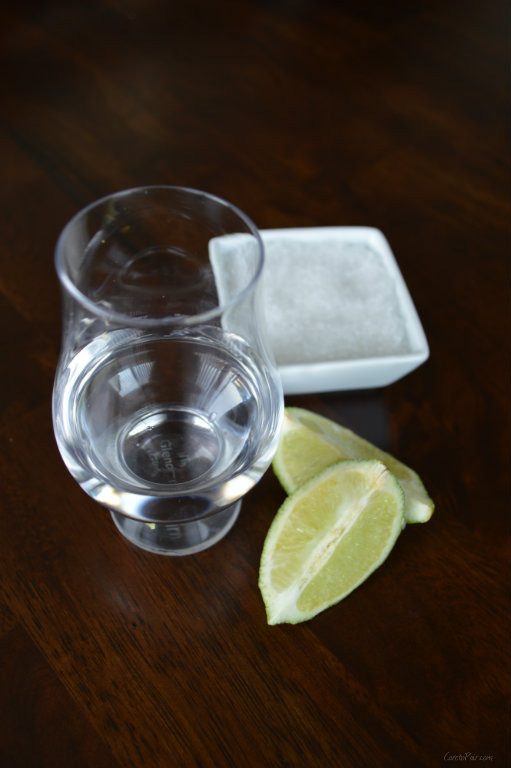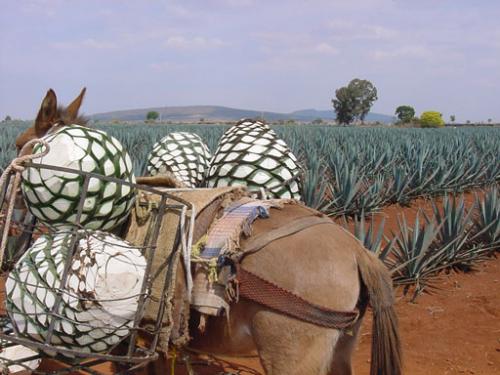A Lesson on Tequila
Lets talk tequila. My blogging buddy from South of Vanilla just posted this awesome blood orange margarita recipe and admitted she “knows nothing about tequila” which got me thinking—do any of us really know much about tequila? Its one of those spirits we all love to sip in our margaritas on hot days, or our most dreaded shot of choice at the bar, but beyond that, not much thought has gone into this delicious libation.But let me tell you....tequila is freaking awesome.
The fact is, a lot of hard work goes into making tequila. First off, tequila comes from the blue weber agave plant, which looks like a cactus but is actually a succulent, part of the lily family. We had a lot of agaves growing around Las Vegas. Tequila-makers have to wait 8-10 years for this blue agave to ripen (that’s a long time!) then chop off all the spines to reveal the heart, or pina, of the plant. Here’s a few pictures to give you a visual:
Look at how huge those things are! That poor horse! Pinas can actually weigh up to 150 pounds, which is madness. I had no idea it took that long or was that labor-intensive to harvest the fundamental product to make tequila. Anyway, after the pinas are harvested, they are brought to the distillery and cut in half. Then they are cooked in slow-baked ovens for 1-3 days. By baking the pina, it converts the starches of the plant into fermentable sugars, which is what we need to make any sort of liquor. After that, the pina is shredded, fermented in a large tank, and then distilled in either copper, stainless steel stills, or continuous stills.
So what is the difference between mezcal and tequila? Obviously, as I just said, mezcal uses other agaves besides the blue weber variety. Mezcal is also older than tequila in that it was the traditional way of making distilled spirits by roasting the pinas over direct fire which gave them a distinct smokey character. In the 16th century, the best known mezcal was produced in a small town called Tequila (see where this is going?). Perhaps this was so popular, because the weber blue agave grew wild around the town, and the distilleries used it to make their mezcal. All distilleries used the name “tequila” to denote where their tequila came from, so the best of the best soon became affiliated with the name “tequila”.
Then, Don Cenobio Sauza (of Sauza tequila, yes) figured out if he steamed or baked the pinas to make his tequila, they wouldn’t taste smokey anymore. Mexicans went crazy over this new style of tequila, so other distillers followed. Tequila became famous as “the drink of Mexico”, so that is the resulting style we know and drink today!
Categories of Tequila
All tequila is categorized by how it long it has been aged. Just like whiskey and scotch however, the longer it has been aged, the higher its price tag will be. I will admit my tequila collection at home is...pretty pathetic...but that's because good tequila is EXPENSIVE! (blame it on the 150 lb pinas they have to wait 10 years to harvest PLUS that aging time...) My biggest advice? Buy the cheaper silver and gold tequilas for your cocktails, and splurge on a nice anejo if you want to start enjoying the good stuff.
Side note--a few weeks ago I made the terrible mistake of ordering a super sugary margarita that immediately messed with my stomach. My friend ordered me a shot of good tequila in which I sipped on for the next 20 minutes. My stomach immediately settled and I felt better. I had no idea tequila could act as a stomach-settler!
The 5 Categories of Tequila
- Silver (White) (Blanco)
- tequila that has not been aged in wooden barrels
- often the most value-driven, designed for everyday consumption
- Gold (Young) (Joven)
- may be aged
- caramel color, sugar syrup, or oak extract may be added to soften flavor
- Reposado (Aged Tequila)
- aged at least 2 months (but up to a year) in oak casks
- Anejo (Aged Tequila)
- Aged in oak a minimum of 1 year (and up to 3 years)
- Extra Anejo (Ultra Aged Tequila)
- Aged in oak a minimum of 3 years



